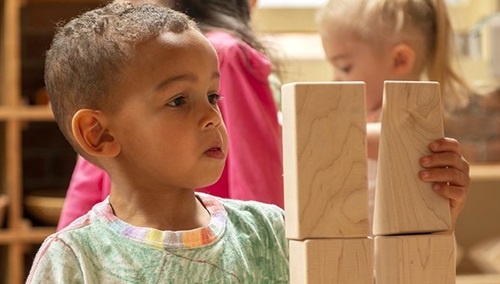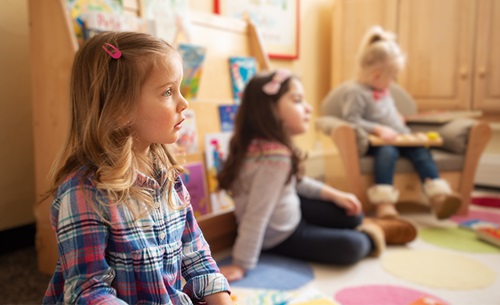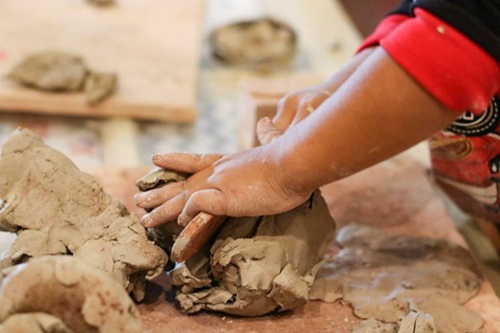Let the Playing Commence!
A Tribute to Bev Bos
| November 2016In Memoriam: Bev Bos (1934-2016)
The early childhood field lost an inspirational leader with the death of Bev Bos on February 4, 2016. She served nearly 50 years as director of Roseville Community Preschool in Roseville, California, and was a national and international keynote speaker and presenter at over 6,000 conferences and workshops. Her passion, enthusiasm, and approach to working with young children were exceptional and she will be deeply missed. She conveyed the following message in a direct and passionate manner, and with every fiber of her being: Play is an overarching and essential contributor to the development of children.
Wonder (curiosity), self-discovery, problem-solving, interaction, exploration, and play—that’s what Bev Bos taught me. Reading and writing come after these approaches to learning are established. Children learn best when they can make their own choices and set their own goals. Because each child is unique, multiple channels of learning must be celebrated. Bev also encouraged families and teachers to be joyful in their engagement with children as they observed and participated in this developmental and educational process.
Some of the phrases Bev used will remain permanently burned on my brain:
Childhood amnesia. If we actually could remember our childhood, we would not do to children what we do to them. Early childhood (ages birth to 8) would still be viewed as a unique period of development with play recognized as being at the core of how children learn best.
We made a mistake calling it preschool. The word “school” conjures up images of teacher as expert, children as sponges—only absorbing information and not being a source of information, the use of desks, listening valued over conversation, quiet environments, and little movement. These descriptors are far removed from what an early learning environment and approach should encompass.
Children don’t learn much through their bottoms. Most adults enjoy remaining stationary as our bodies get weary. Many classrooms are set up to keep us sitting and thus supposedly attentive. In contrast, young children actually expend much more energy trying to remain stationary. Their muscles (and thus their brains) demand that they move their bodies.
Never do for children something they can do for themselves. I often observe this sage advice being ignored, possibly because adults are time-bound whereas children are living in the moment. We hurry, hurry, hurry children to try to save time, quickly completing tasks instead of encouraging them to take on the challenges.
Experience is not the best teacher; it is the only teacher. Children must interact with real people and real things; they need to encounter problems and figure out how to solve them when something doesn’t go as one would hope; curiosity and trial-and-error must be championed.
If it hasn’t been in the hand and the body, then it can’t be in the brain. Another endorsement of experiential and hands-on learning.
Children were not born wearing shoes. Remember how good mud felt between your toes? Can we even remember the joy that rippled through our bodies and brains when we squished mud between our fingers and toes? Provide sensory experiences every day for children.
Children have to do and use too much of everything in order to figure out the world. This is at the heart of understanding how important mess and repeated activities are in helping children make sense of their worlds.
Ooops! Learning sometimes involves a big mess!
All learning involves risk. The environment and adults must provide opportunities for risk-taking in the learning process; ‘mistakes’ are expected components of the inquiry process and valued for the knowledge they provide. Risk is not to be confused with hazard. Bev noted that we need to consider the ‘illusion of risk.’ It is our responsibility as educators to figure out how to provide experiences that children perceive as containing elements of risk, but in reality are still safe in nature. We also need to explain to families why children need to take risks: through risk-taking experiences children learn to match their skills to the demands of the task. This is a delicate balance because our society is risk-averse due to potential legal ramifications. However, the neurological feedback children gain from the trial and error of risk-taking enables them to develop the precursor skills in their brains that will enable them to manage risk assessment as adults.
Earliest isn’t best. Fastest isn’t best. “If what we want for our children is a lifetime of excellence—in experience, in ability, in knowledge—we must be responsible enough to wait and thorough enough to look at all sides of their development” (Bev Bos). We need to pay attention to how we can help foster children’s engagement in learning so that they become lifelong learners. Children’s brains have not changed; only the expectation about what children should be doing. These unrealistic expectations that ignore well-known and researched child development principles are having a deleterious impact on children’s social competence and their ability to become successful learners in academic settings. A holistic approach to the education of young children must be adopted and practiced, not just in preschool but up to third grade (at least).
Our flexibility and willingness to follow a child’s lead will allow remarkable things to happen, if we let them. This is about trusting children and not being afraid to examine and explore; we should model how to go about finding answers to questions. The unknown should be celebrated as an opportunity for learning, not as a fearsome threat to our power as teachers.
Sharing books with children is an invitation for a conversation. Although we should strive to read high-quality literature with children, the focus is not just on the content contained within the pages. What is also important is the conversation adults have with the child (children) about the story and illustrations before, during, and after the reading. This is because authentic learning occurs when it is connected to meaningful experiences that are mediated with a caring adult. Books are a catalyst for sharing memories, values, and beliefs, as well as bridges to prior learning that help to support children’s burgeoning understanding of their day-to-day lives. In fact, Bev never thought it was important to finish a story. If a child wants to stay on the first page of a book, showing full engagement and asking a host of questions, then that is perfectly acceptable. It is the rich conversation that is important.
Ask: “Whose needs are being met?” When Bev was on her first visit to Chautauqua County, I remember her marveling at our colorful leaves, since Northern California does not have the variety of trees that exist here. She gathered up several bagsful from my yard, as well as at other stopping points in our travels, to take back to the children at Roseville. During her next visit, she arrived excited to share a most fantastic experience that had occurred at her preschool. She had arranged for a dump truck to deposit a load of sand directly into the classroom. She joyfully described the delight the children had in playing indoors on the big pile of sand and how they gradually, over a two-month period, carried the sand outdoors in small buckets. (Two hours earlier some teachers from a local Head Start program had shared with me the devastating news that their sand tables had been removed from the classrooms. Why, I asked? The answer was because the sand was wearing away the fiber of the new carpets.) The juxtaposition of these two opposite approaches to being with children astounded me and compelled me from that day forward to encourage teachers to always ask themselves one of the most important questions in decision making: Whose needs are being met?
Our challenge is not to prepare children for school, but to prepare schools for children. (Docia Zavitskovksy)
Bev had this quote written on one of the walls at the Roseville Community Preschool, helping remind her (and all of us) about what is important when we take on the responsibility to be with children.
These words prompt us to acknowledge that getting children ‘ready’ is not an end goal that we should want to achieve. Children possess a different temporal sensibility than adults. They do not regularly think about tomorrow, nor do they very often contemplate yesterday. They live in the present moment; we need to join them there if we do not want to miss out on how they are thinking, investigating, and creating their world. A practice of mindfulness is required so that we can be with children now.
Finally, Bev had the ability to make everyone around her feel competent and interesting, encouraging us to share our stories of success and failure in order to envision the next steps in our professional development. She loved the learning journey that children were experiencing. She knew that the best job anyone could have in life was discovering the world over and over again through the bright eyes of children. The joy she shared about teaching young children was infectious and I will never forget her laugh. I don’t know whether Bev thought of herself as an agent of change in the field of early childhood, but she was and will remain so as her ideas and philosophy will continue to ripple out like swells in the ocean. So, in tribute to Bev, let the playing commence!
Copyright © Exchange Press, Inc. Reprinted with permission from Exchange magazine. All rights reserved. Visit us at www.ChildCareExchange.com or call (800) 221-2864.









